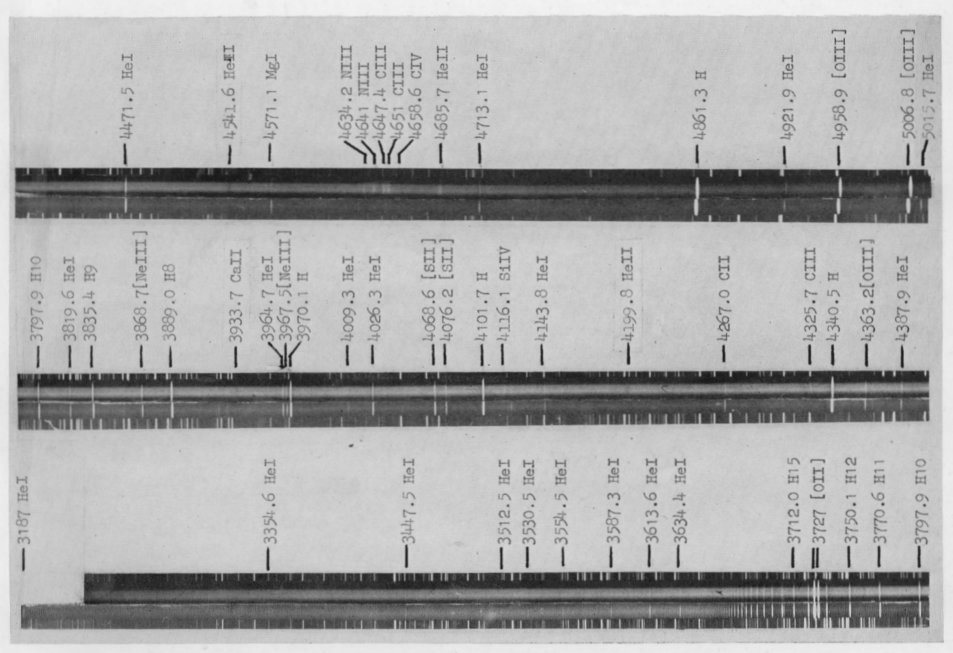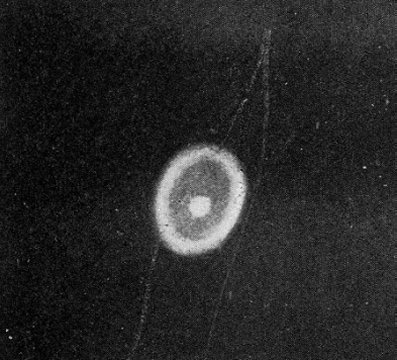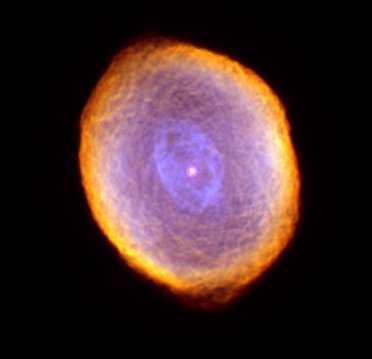IC 418
THE SPIROGRAPH NEBULA
"Exceedingly bright" (Curtis): both the planetary nebula and the 10th
magnitude (10.2) central star. As NGC
7027 and NGC 2440 are to high-
excitation planetary nebulae and ultra-hot stars, IC 418 (the
Spirograph, in Lepus) is to low-
excitation nebulae and cool stars (cool at least in the context of
the planetary nebulae). Calculations of temperature from three
different methods (nebular emission spectrum compared to the
star, the nebula alone, the star's spectrum alone) cluster nicely
around 35,000 Kelvin, not that much above the 26,000 Kelvin lower
limit, below which the star cannot ionize the nebula. Even at 35,000 K,
the star is so "cool" that only about 75 percent of the nebular
helium is ionized. A stellar wind is evident from the star's
spectrum, which contains broad emission lines of highly ionized
carbon and helium.
The distance is uncertain. The best two estimates give
2500 light years, though the range goes all the way to 6500. The
shorter distance gives a stellar luminosity of around 1500 times
that of the Sun. Curtis, whose composite
drawing is at the left, measures an angular diameter of 13 seconds
of arc, Hubble scientists (on the right) 18 seconds, though Curtis
does state that a "long exposure...shows the object as somewhat
larger..." At 18 seconds and 2000 light years, the ionized shell
of IC 418 is then 0.2 light years across. (There is almost
certainly un-ionized matter around the visible ring.) The small
size is consistent with the low star temperature of early
evolution, as the star is still heating and the nebula growing,
albeit at a low expansion rate of 12 kilometers per second (rather
typical of low excitation objects).
Rotate the Hubble image about 45 degrees to the right to
match the two. Curtis sees the interior filled with a light glow,
which the powerful resolution of the Hubble reveals to consist of
a filigree pattern and an inner ring. Curtis sees the star off-
center, while in the Hubble image, the star is off-center in the
faint inner ring. The observers, however, are not seeing quite
the same things, as the older image is a visual impression, the
Hubble made from a set of images that reflect specific emission
lines. The outer ring is also subtly bi-polar, rather reminiscent
of the Ring Nebula in Lyra, perhaps
showing us what the Ring used to look like.
Left: Image and quotes by H. D. Curtis from Publications of the
Lick Observatory, Volume 13, Part III, 1918. Right: NASA and the
Hubble Heritage Team (STScI/AURA).
 |
Historical blue to near-ultraviolet photographic spectra
of IC 418 taken with the coude spectrograph of the 120-inch
telescope at Lick Observatory. The scale is in Angstroms. The
upper spectrum is that of the nebula plus the central star, while
the lower one is that of the nebula only. Emission-line comparison
spectra used for wavelength measure bracket those of the nebula.
Note the broad ionized helium, carbon, and nitrogen lines in the
top strip that come from the wind of the central star. The low
excitation nebula, with its relatively cool central star, does not
exhibit He II emission lines (those of ionized helium), just those
of He I (neutral helium). Square brackets denote forbidden lines.
At the right end of the top strip lie the famed "nebulium" lines
at 5007 and 4959 Angstroms first found in the spectrum of NGC 6543 by Sir William Huggins. The bottom
strip clearly shows the confluence of the hydrogen Balmer lines,
which merge into the strong Balmer continuum, and the splitting of
the forbidden [O II] line at 3727 Angstroms. For additional
discussion see The Ring Nebula
From L.H. Aller and J.B. Kaler, Astrophysical
Journal vol. 140, p. 936, 1964.




